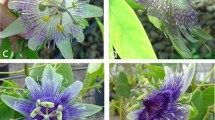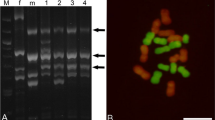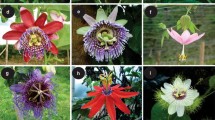Abstract
Three new varieties of Passiflora hybrids were developed from crosses between P. sublanceolata J. M. MacDougal (ex P. palmeri var. sublanceolata Killip) versus P. foetida var. foetida L. Twenty putative hybrids were analyzed. Hybridizations were confirmed by RAPD and SSR markers. The RAPD primer UBC11 (5′-CCGGCCTTAC-3′) generated informative bands. The SSR primer A08FP1 amplified species-specific fragments and heterozygote status was observed with the two parent bands 240 and 280 bp. The molecular markers generated by primers were analyzed in terms of the presence or absence of specific informative bands. The morphological characterization of the hybrids enabled their differentiation into three groups, identified as: (1) Passiflora ‘Alva’, composed of five hybrid plants with white flowers, large corona, light purple filaments at base, white and purple/white banding to apex; (2) P. ‘Aninha’, composed of six hybrid plants with pale pink flowers, corona filaments reddish/purple at base, white, purple/white banding to apex; (3) P. ‘Priscilla’, composed of nine hybrid plants with white flowers, small corona, filaments dark purple at base, white and purple to apex. The genomic homology of parent plants was verified by cytogenetic analysis. Both parents were 2n = 22. Meiosis was regular in genitors and hybrids. Aneuploidy was observed at hybrid groups P. ‘Alva’ and P. ‘Priscilla’ (2n = 20). Other authors had already observed the same number of chromosomes for some P. foetida genotypes. Obtaining valuable interspecific hybrids opens up new perspectives to offer opportunities in agribusiness for producers and to arouse the interest of consumers into using passion flowers in the Brazilian ornamental plant market.




Similar content being viewed by others
References
Abreu PP (2008) Análises em Passiflora palmeri, Passiflora foetida e híbridos F1 ornamentais: relações citogenéticas e caracterização fisiológica. Dissertation, Universidade Estadual de Santa Cruz
Abreu PP, Sousa MM, Santos EA, Pires MV, Pires MM, Almeida A-AF (2009) Passion flower hybrids and their use in the ornamental plant market: perspectives for sustainable development with emphasis on Brasil. Euphytica 166:307–315
Beal PR (1969) Cytology of the native Australian Passiflora species. 1. Chromosome number and horticultural value. Queensland Journal of Agricultural and Animal Sciences 26:407–421
Benevides CR, Gaglianone MC, Hoffmann M (2009) Visitantes florais do maracuja-amarelo (Passiflora edulis f. flavicarpa Deg. Passifloraceae) em áreas de cultivo com diferentes proximidades a fragmentos florestais na Região Norte Fluminense, RJ. Revista Brasileira de Entomologia 53:415–421
Berry PE (2011) Passifloraceae. Encyclopædia Britannica. Encyclopædia Britannica online. Encyclopædia Britannica Inc., 2011. Web. 15 Nov 2011. http://www.britannica.com/EBchecked/topic/445748/Passifloraceae
Borém A (1997) Melhoramento de plantas. Editora UFV, Viçosa
Bowden WM (1945) A list of chromosome numbers in higher plants. II. Menispermaceae to Verbenaceae. Am J Bot 32:191–201
Bruckner CH, Otoni WC (1999) Hibridização em Maracujá. In: Bórem A (ed) Hibridização artificial em plantas. Editora UFV, Viçosa, pp 379–399
Caetano-Pereira CM, Pagliarini MS (2001) A new meiotic abnormality in Zea mays: multiple spindles associated with abnormal cytokinesis in both divisions. Genome 44:865–871
Cervi AC (2005) Espécies de Passiflora L. (Passifloraceae) publicadas e descritas nos últimos 55 anos (1950–2005) na América do Sul e principais publicações brasileiras. Estudos de Biologia 27:19–24
Cervi AC, Linsingen L (2010) Passiflora kikiana, a new species of Passifloraceae from the Brazilian Amazon. Acta Botanica Brasilica 24:1062–1064
Defani-Scoarize MA, Pagliarini MS, Aguiar CG (1996) Meiotic behavior of inbred lines of maize (Zea mays L.). Nucleus 39:10–18
Doyle JJ, Doyle JL (1990) Isolation of plant DNA from fresh tissue. Focus 12:13–15
Faleiro FG, Pires JL, Lopes UV (2003) Uso de marcadores moleculares RAPD e microssatélites visando a confirmação da fecundação cruzada entre Theobroma cacao e Theobroma grandiflorum. Agrotropica 15:41–46
Feuillet C, Frank A, Kugler E, Laurens C, MacDougal J, Skimina T, Vanderplank J (2000) Notes on the Passiflora cultivars list—Passiflora cultivars registration committee. Passiflora 10:22–39
Johansen DA (1940) Plant microtechnique. McGraw Hill, New York
Junqueira NTV, Braga MF, Faleiro FG, Peixoto JR, Bernacci LC (2005) Potencial de espécies silvestres de maracujazeiro como fonte de resistência a doenças. In: Faleiro FG, Junqueira NTV, Braga MF (eds) Maracujá: germoplasma e melhoramento genético. Embrapa, Planaltina, pp 80–108
Junqueira KP, Faleiro FG, Junqueira NTV, Bellon G, Ramos JD, Braga MF, Souza LS (2008) Confirmação de híbridos interespecíficos artificiais no gênero Passiflora por meio de marcadores RAPD. Rev Bras Frutic 30:191–196
Killip EP (1938) The American species of Passifloraceae. Field Mus Nat Hist Bot Ser 19:1–613
Linde-Laursen I, Von Bothmer R (1999) Orderly arrangement of the chromosomes within barley genomes of chromosome-eliminating Hordeum lechleri × barley hybrids. Genome 42:225–236
Linnaeus C (1753) Species plantarum 2. L. Salvius, Stockholm
MacDougal JM (2004) Six new taxa of Passiflora (Passifloraceae), with nomenclatural notes on the genus in Mesoamerica. Novon 14:44–462
Magdalita PM, Drew RA, Adkins SW, Godwin ID (1997) Morphological, molecular and cytological analyses of Carica papaya × C. cauliflora interspecific hybrids. Theor Appl Genet 95:224–229
Manica I (1981) Fruticultura: 1. Maracujá. Editora Ceres, São Paulo
Meletti LMM (2005) Melhoramento genético do maracujá: passado e futuro. In: Faleiro FG, Junqueira NTV, Braga MF (eds) Maracujá: germoplasma e melhoramento genético. Embrapa, Planaltina, pp 55–78
Mendes-Bonato AB, Pagliarini MS, Valle CB (2006) Abnormal spindle orientation during microsporogenesis in an interspecific Brachiaria (Gramineae) hybrid. Genetics and Molecular Biology 29:122–125
Munsell Color Company (1977) Munsell color chart for plant tissue. Munsell Color Company, Baltimore
Naci Onus A, Pickersgill B (2004) Unilateral incompatibility in Capsicum (Solanaceae): occurrence and taxonomic distribution. Ann Bot 94:289–295
Oliveira RP, Novelli VM, Machado MA (2005) Freqüência de Híbridos em Cruzamento entre Tangerina ‘Cravo’ e Laranja ‘Pêra’. Pesqui Agropecu Bras 35:1895–1903
Pádua JG, Oliveira EJ, Zucchi MI, Oliveira GCX, Camargo LEA, Vieira MLC (2005) Isolation and characterization of microsatellite markers from the sweet passion fruit (Passiflora alata Curtis: Passifloraceae). Mol Ecol Notes 5:863–865
Palmer RG, Albertsen MC, Horner HT, Skorupska H (1992) Male sterility in soybean and maize: developmental comparisons. The nucleus 35:1–18
Passiflora Society International (2008) http://passiflora.org/?page_id=30. Accessed 01 Oct 2009
Peixoto M (2005) Problemas e perspectivas do maracujá ornamental. In: Faleiro FG, Junqueira NTV, Braga MF (eds) Maracujá: germoplasma e melhoramento genético. Embrapa, Planaltina, pp 457–464
Rao SV, Rao BGS (1984) Studies on the crossability relationships of some spinous Solanum. Theor Appl Genet 67:419–426
Riddle NC, Birchler JA (2003) Effects of reunited diverged regulatory hierarchies in allopolyploids and species hybrids. Trends Genet 19:597–600
Schueler S, Tusch A, Schuster M, Ziegenhagen B (2003) Characterization of microsatellites in wild and sweet cherry (Prunus avium L.)—markers for individual identification and reproductive processes. Genome 46:95–102
Shamina N, Dorogova N, Trunova S (2000) Radial spindle and the phenotype of the maize meiotic mutant, dv. Cell Biol Int 24:729–736
Singh RJ (2002) Plant cytogenetics. CRC Press, Boca Raton
Soares-Scott MD, Meletti LM, Recco-Pimentel SM (2003) Meiotic behaviour and pollen fertility in sexual and somatic hybrids of Passiflora species. Caryologia 56:129–138
Souza MM, Pereira TNS (2011) Biologia da reprodução em maracujazeiro amarelo e sua importância para a produção comercial de frutos. In: Pires MM, São José AR, Conceição AC (eds) Maracujá: avanços tecnológicos e sustentabilidade. Editus, Ilhéus, pp 175–201
Souza MM, Pereira TNS, Viana AP, Pereira MG, Bernacci LC, Sudré CP, Silva LC (2003) Meiotic irregularities and pollen viability in Passiflora edmundoi Sacco (Passifloraceae). Caryologia 56:161–169
Storey WB (1950) Chromosome numbers of some species of Passiflora occurring in Hawaii. Pac Sci 4:37–42
Thiruvengadam V, Muthiah A (2007) Interespecific hybridization between Cajanus cajan and Cajanus cajanifolius. Crop Breed Appl Biotechnol 7:204–211
Torres RR, Martin FW (1974) First-generation hybrids of edible passion fruit species. Euphytica 23:61–70
Ulmer T, MacDougal JM (2004) Passiflora: passionflowers of the world. Timber Press, Portland
Vanderplank J (2000) Passion flowers. The MIT Press, Cambridge
Vanderplank J, Blanco EG, Feuillet C, Frank A, King L, Kugler E, Laurens C, MacDougal J, Skimina T (2003) The international Passiflora register 2003. Passiflora 1:1–36
Viana AJC, Araújo IS, Souza MM, Ahnert D, Corrêa RX (2006) Otimização da extração de DNA de espécies de Passiflora L. visando obtenção de marcadores RAPD. Magistra 18:88
Acknowledgments
The authors wish to thank Programa de Pós-Graduação em Produção Vegetal and Coordenação de Aperfeiçoamento de Pessoal de Nível Superior (CAPES) for the scholarship of the first author; Fundação de Amparo à Pesquisa do Estado da Bahia (FAPESB), Conselho Nacional de Desenvolvimento Científico e Tecnológico (CNPq) and Universidade Estadual de Santa Cruz (UESC) for financially supporting the research; Dr. Armando Carlos Cervi (Universidade Federal do Paraná—PR, Brazil) and Dr. Luiz Carlos Bernacci (Instituto Agronômico—Campinas, SP, Brazil) for the taxonomic identification of parents.
Author information
Authors and Affiliations
Corresponding author
Rights and permissions
About this article
Cite this article
Santos, E.A., Souza, M.M., Abreu, P.P. et al. Confirmation and characterization of interspecific hybrids of Passiflora L. (Passifloraceae) for ornamental use. Euphytica 184, 389–399 (2012). https://doi.org/10.1007/s10681-011-0607-7
Received:
Accepted:
Published:
Issue Date:
DOI: https://doi.org/10.1007/s10681-011-0607-7




